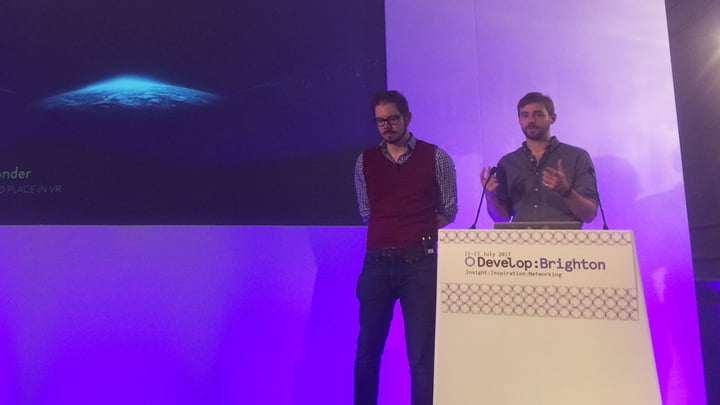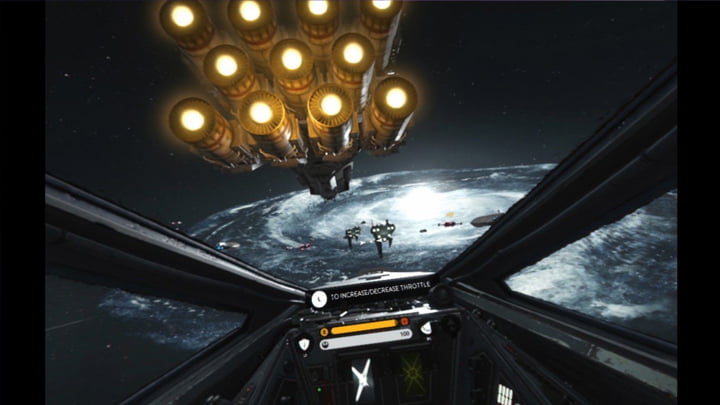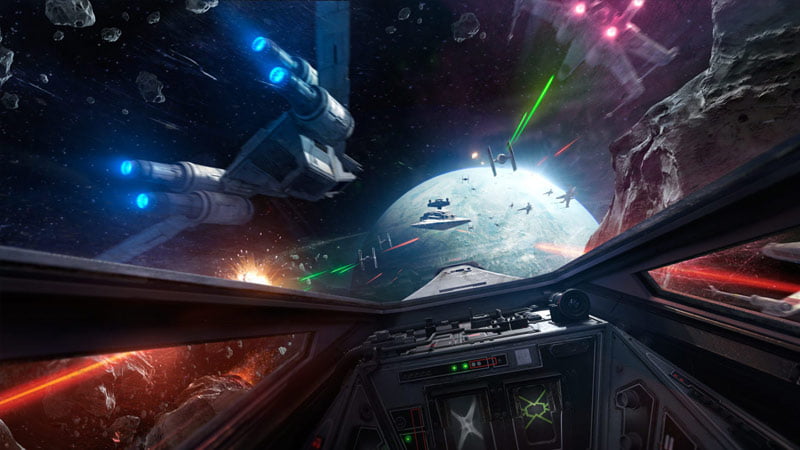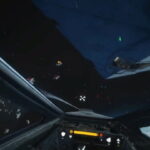At Develop:Brighton 2017, Kieran Crimmins and James Svensson revealed how Criterion created one of Star Wars’ most iconic moments in VR.
Star Wars Battlefront Rogue One X-Wing VR Mission is one of the highlights of the PlayStation VR library. The short expansion to Star Wars Battlefront was released in December 2016, and gives aspiring Rebel pilots the chance to fulfil their childhood dreams by taking control of an X-Wing fighter.
Although short, the mission – which ties into the events of the movie Rogue One – evokes a number of iconic Star Wars moments, be it the sight of an AT-AT Walker lumbering across the title screen, or the feeling of unbridled joy as you look behind you and realise that, yes, of course there’s an R2 unit there.
It’s magical stuff, with the most effective example coming towards the end of the mission when the sudden appearance of a Star Destroyer recreates the opening seconds of the first Star Wars film.
It’s a thrilling sight that demonstrates how VR uses scale and distance in a way that traditional video games cannot replicate. However, making that moment work was not as simple as just porting a standard Star Wars Battlefront space mission into VR. With the player free to look around, and do what they want, an invisible guiding hand was required to give the scene the necessary impact.
In their talk at Develop:Brighton 2017, Criterion’s Kieran Crimmins and James Svensson explained how the studio made a childhood dream come true.

Svensson – Producer & Art Director at Criterion Games – says that the first thing to understand when developing for VR is that you are, in effect, creating a role-playing experience.
“In VR, once you put the headset on, you are asking the player to look around,” he says.
“And just by that act of looking around they are already roleplaying. VR is role-playing by default. We have no control over the player, they are just inhabiting the space we have created.”
Looking, however, is one thing. Looking and moving – something that is fundamental in a game based on Star Wars – is something else entirely, and not without considerable development challenges.
In creating X-Wing VR mission, Criterion naturally began by looking at the existing space combat model used in Star Was Battlefront.
“By default the Battlefront handling – which is very arcadey – was incredibly nauseating. It has a lot of auto-roll. If you flew upside down it would correct you to be the right way up,” Svensson explains.
The result was not comfortable experience, but these early tests were invaluable to the team in highlighting the importance of one factor: anticipation.
“Fulfilling peoples expectations, and being very consistent with your movement, that was the biggest thing,” says Svensson.
“Also, building as much anticipation as is possible, so that when the camera starts turning there are lots of things that lead the player to it, and they feel in control.”
The key is to never take camera movement away from the player. To the player it’s not a camera, it’s like having the whole world move around you.
One technique Criterion used to enhance comfort was to break the X-Wing’s flight movement into three independent, but connected parts. A nudge of the thumb stick starts a chain reaction that begins with the movement of the onscreen reticule, this is then followed by the chassis, and then, finally, by the X-Wing itself.
“The player has all this time to anticipate that movement before it starts,” says Svensson.

The development team quickly decided that Star Wars Battlefront Rogue One X-Wing VR Mission had to include a version of that most iconic of cinematic moments, the arrival of a Star Destroyer.
“For VR that’s a huge challenge,” admits Svensson.
“You’ve got to have the player looking in a particular direction, and when you have this thing coming overhead, how do you get this sense of motion across without creating the feeling you’re going backwards?”
Several gameplay and design elements had to be coordinated to ensure the final sequence could be achieved without completely disorienting the player.
“The level design at this point was going in one direction,” says Svensson, referring to the game’s narrative. At this stage of the game, the player is moving in one specific direction to complete a mission objective, the rescue of a U-Wing fighter.
“This really helped with the sense of orientation, the player always knew which way was north and which way was up. You’re rescuing an objective which is always in front of you, and it’s artificially always just pushing ahead of the player. Whatever speed you’re going, it’s always going to be 10-20 metres ahead of you.”
And by keeping that objective just out reach, the team could make an assumption that the player would be in the correct position when the moment came.
“It gives you a sense of purpose and a sense of direction. You’re free to go and chase the TIE fighters all you want, but it always gives you this point to return to.”
To pre-empt the arrival of the Star Destroyer, a number of other factors also came into play.
“Before the Star Destroyer comes in, we’ve got the Corvette that flies in. That’s there as your meeting point, the rendezvous, and it gives this focal point which again leads the player to point in that direction,” says Svensson.
“At that moment we also take over the AI, so all the ships head towards that point as well. So by that stage we have the player mostly looking in the right direction.”
And then the moment begins. A Star Destroyer flies in overhead, announcing itself with a huge barrage of laser fire that destroys the Corvette.
“That’s a really cool moment because it catches people by surprise,” says Svensson.
“As well as having you facing the right direction, the lasers really draw your eye to right where you’re meant to be looking. And then, the audio of the explosion really sucks everything else out of the scene. The VFX then kick off with a big, blinding flash in front of you, again drawing your eyes forward.”
The result is that, for most players, there’s a sense of something happening just as the Star Destroyer enters at the top of the screen.
However, with a such a large object taking up the entire field of view, Criterion had to try to avoid players feeling the sensation of be pulling backwards.
“That was something that tested badly fairly early on,” Svensson says.
The answer was remarkably simple. A case of smoke and mirrors, of mind over matter.
“If the player feels like they are being pulled back, why don’t we just disable their ship, and make a narrative reason for them to feel like they are being pulled back. And that really worked.”
The narrative justification helps the player anticipate that feeling of motion as the Star Destroyer enters the fray. There was also an emotional upside to this technique. As power returns to the X-Wing, the player feels like they are coming back into the fight, giving the game a heroic moment that enhances that role-playing feel.
“Through constantly keeping in mind comfort, alongside gameplay, alongside emotion, and through building all of those things together, we were able to get something that worked for most of our players.” says Svensson.









